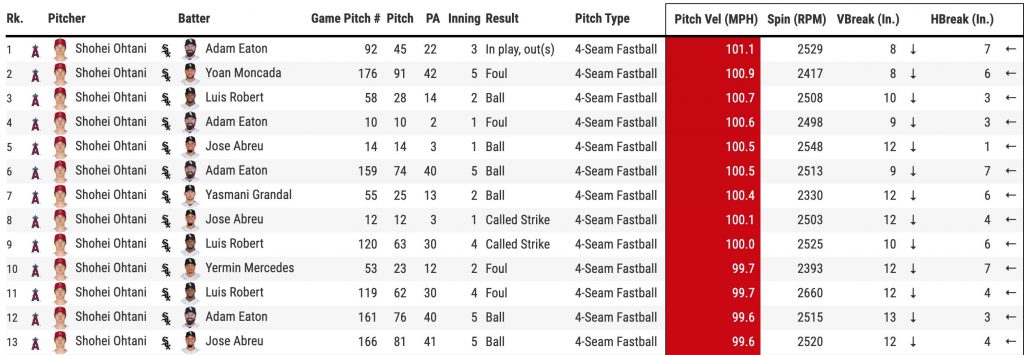It’s not hyperbole to say that Shohei Ohtani had a historic performance on Sunday Night Baseball.
According to the ESPN broadcast, Ohtani was the first starting pitcher since 1903 to both start on the mound and bat second in the lineup. It was one thing to simply be the first to do this in over a century; it’s an entirely different thing to go out and actually justify it. While Ohtani’s outing ended in a bizarre and scary fashion (the Angels say he’s fine), it was a truly unforgettable performance from the sport’s most unique player. Here are the numbers that defined Ohtani’s outing from one of the most incredible performances in MLB history.
451, 115.2
Those numbers represent the distance (451 feet) and exit velocity (115.2 mph) on Ohtani’s first-inning blast. Ohtani wasted no time in making the transition from the mound to the plate by blasting the first pitch he saw into the right-field pavilion. Both the distance on that home run and the exit velocity are career-bests for him, a mind-boggling thought given the damage Ohtani has done as a hitter in the majors so far. Can you say #PitchersWhoRake?
101.1
Ohtani topped out at 101.1 mph on Sunday, tied for his career-best (he did it once in May of 2018). Kudos to Adam Eaton for not only making contact with this pitch but also putting a pretty good whack on it (89.1 mph exit velocity). Ohtani hit this figure a mere two innings after hitting a baseball 451 feet. Suffice to say that nobody else in the game is capable of hitting a baseball that far and throwing a baseball that fast.
13
That’s the number of times Ohtani hit 100 mph on the mound on Sunday. Technically, it’s 99.5+ mph but we’re rounding up much as the broadcasts do around the league. That’s a career-high for Ohtani who reached the next level on his already elite fastball (in terms of velocity). His velocity was up from 96.7 mph in 2018 to 98.1 mph last night and he did not throw a single fastball slower than 93.2 mph. The command on the pitch wavered and opposing hitters did square it up (98.2 mph exit velocity) but the sheer velocity was insane as was the improved spin rate (more on this later).

15
That’s the number of times that Ohtani either hit 100 mph on the mound or hit a baseball with a 100+ mph exit velocity. In addition to those 13 heaters at 100+ mph, he also squared up two baseballs at the plate. After hitting his mammoth of a home run in the first inning, he hit an absolute laser in his second plate appearance at 109.7 mph, a lineout that was hit right at White Sox center fielder Luis Robert. Ohtani didn’t just top the leaderboard in velocity on the mound; he had the two hardest-hit baseballs at the plate. Here are all 15 of those 100+ mph baseballs on both sides of the ball.
1068
That’s the combined average spin rate increase (RPM) Ohtani had on his four pitches compared to his 2018 numbers. Ohtani wasn’t just throwing the ball harder; he was spinning the ball at a significantly higher level. Ohtani’s always thrown hard but he had subpar spin rates on all of his pitches back in 2018. Velocity sometimes isn’t enough at the highest level and the combination of both more velocity and spin bodes well for Ohtani’s success on the mound.

Didn’t have an idea of the spin rates which probably isn’t covered in other media.
Thanks for the article. Hopefully we can have this throughout this season.
This Kid is Overhyped!
You can’t be serious?
He’s from Bleacher Report…
Tommyshalo got the reference to the Overhyped article
Really fun article thanks for writing that up
Absolutely amazing game for Ohtani. Great recap of it.